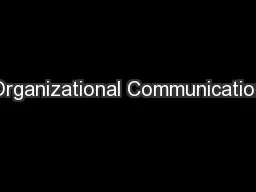

Chapter 2 Classical Approaches Organizational Communication In the beginning A considerable part of what we today deem organizational communication research is an attempt to explain how a large number of humans can function together as a machine ID: 406767
Download Presentation The PPT/PDF document "Organizational Communication" is the property of its rightful owner. Permission is granted to download and print the materials on this web site for personal, non-commercial use only, and to display it on your personal computer provided you do not modify the materials and that you retain all copyright notices contained in the materials. By downloading content from our website, you accept the terms of this agreement.
Slide1
Organizational Communication
Chapter 2
Classical ApproachesSlide2
Organizational Communication: In the beginning...
A considerable part of what we today deem organizational communication research is an attempt to explain how a large number of humans can function together as a machine.
It is not surprising then that the
organization
as machine
metaphor has given rise to several organizational communication theories.Slide3
Machine Metaphor
An organization is like a machine b/c its:
Specialization
Everyone has a special role
Standardization
Very replaceable
PredictabilitySlide4
The
Classical Organization
Modern Times-Charlie Chaplin
(Part One)
http://www.youtube.com/watch?v=qDnDaDYZ2AQ&feature=related
Modern Times-Charlie Chaplin
(Part Two)
http://www.youtube.com/watch?v=7fyyt3JGGvk&feature=relatedSlide5
Fayol’s Theory of Classical Management
Elements of management (What?)
Planning
Organizing
Commanding
Coordination
ControlSlide6
Fayol’s Theory of Classical Management
Principles of management (How?)
Organizational structure
Scalar chain
Unity of command
Unity of direction
Division of labor
Span of control
Organizational power
Organizational reward
Organizational attitudeSlide7
Examples of Organizational Charts
http://www.usdoj.gov/dojorg.htm
http://www.mitsue.co.jp/english/company/chart.html
http://www.fema.gov/pdf/about/org_chart.pdf
http://www.wacom.co.jp/english/corporate/outline_diagram.html
http://www.louisville.edu/athletics/Organizational_Chart-U_of_L_Athletics.htm
http://www.martinfowler.com/apsupp/accountability.pdf#search=%22Organizational%20Hierarchies%22Slide8
Examples of Organizational ChartsSlide9
Examples of Organizational ChartsSlide10
Weber’s Theory of Bureaucracy
Closed system
Driven by rational and legal authority
Centralized power and control
Clearly established hierarchy
Void of emotions
6 facets of bureaucracySlide11
Taylor’s Theory of Scientific Management
Focus on micro-level of organizational function
Prescriptive
Relational focus
Worker to worker/worker to boss
Motivation
Uneven work
Systematic soldieringSlide12
Taylor’s Theory of Scientific Management
Four tennets
One best way to do a job
Proper selection of workers for a job
Proper training
Division of labor between manager & workersSlide13
Communication in a Classical Organization
This theoretical approach impacts organizational communication several ways:
1. The communication content within a classic management organization is task-based (maintenance)
2. The direction of communication within a classic management organization is mainly downward.
3. Written communication is the pervasive channel for communicating.
4. The style of communication is formal and distant.Slide14
Remember
Machine Metaphor
Fayol’s Theory of Classical Management
Weber’s Theory of Bureaucracy
Taylor’s Theory of Scientific Management